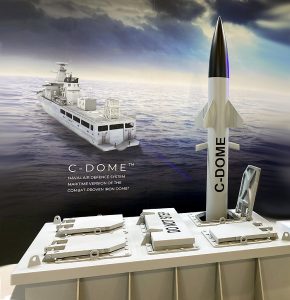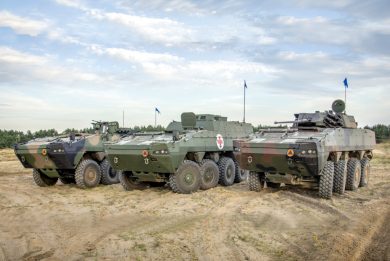
IMDEX 2023 – C-Dome Mission Module for protecting naval units
Providing a defence capability against air threats even to those ship that are not designed to have such capacity since inception, this was the idea that led Rafael developing the C-Dome Mission Module that was unveiled at IMDEX, the International Maritime Defence Exhibition and Conference, taking place May 3-5 at the Changi Exhibition Centre in Singapore,
This solution leverages the work done on the well-known Iron Dome, which ensured the protection of Israel against the frequent rocket and missile attacks coming from neighbouring countries. With over 5,000 combat interception, defining the Iron Dome combat proven might sound as an understatement.

The first naval development of the Iron Dome was the C-Dome, which comes as an integrated solution to be installed into combat ships. The Israel Navy conducted operational tests of the system on its 1,900-tonnes Sa’ar 6 corvette and is expected to equip the smaller Reshef class combatant vessels under design by Israel Shipyards with same C-Dome.
However, Rafael collected a strong interest for a plug-and-play and fully autonomous system with a reduced footprint for those naval platforms such as logistic support or amphibious ships which do not require a combat suite but a tailored protection capacity when needed, in the specific case oriented toward air defence. The same concept however applies to light combatant vessels such as OPVs, which are not armed with a complete combat suite, but might need such capability when deployed in theatre of operations.
The C-Dome Mission Module unveiled at IMDEX does not need full integration in the vessel, being capable to be embarked only when the threat is evident, and removed once the ship goes back to its usual role. The Mission Module concept does not require deck penetration, vessel hull retrofit, cable routing or complex integration with the ship’s systems. Moreover, thanks to its reduced footprint it can be embarked on vessels which before couldn’t be equipped with an air self-defence umbrella. Thanks to its own and independent sensors, it can conduct the full engagement cycle from search to tracking targets in support of C-Dome interceptors. The latter can be shared in a networked air defence system in order to also protect nearby vessels or landing forces in case of amphibious operations.

The system is composed of two main items: a Command, Control and Detection shelter and a Launcher Module. The first is equipped with three workstations and can be linked to the ship existing surveillance and tracking radar. Otherwise, it comes with an EO/IR and a multi-function radar suite added on top of the shelter. Rafael has so far integrated its Toplite EO/IR turret and a Rada radar with a 360° coverage thanks to four fixed faces, but the system can be directed by other radar and EO/IR turret in service or selected by customers, assuming the necessary specifications and capabilities can be combined with C-Dome interceptors.
The Launcher Module, of which up to four can be integrated into the system, is 6.1 metres long, 2.4 metres wide and 4.4 metres high, and can accommodate two vertical launchers with 10 interceptor each in a standard 20-foot ISO standard loading surface, for a total of 20 interceptors per Launcher Module and a total weight of 12 tonnes. Typically, the two elements would be deployed on the ship’s flight deck or free space on the main deck, providing a defence capability against most modern threats, including cruise missiles, antiship missiles either ship- or land-based, as well as against UAVs.
The maintenance-free Tamir interceptor can reach a Mach 2.2 speed, is fitted with a proximity fuse, and has an operational range reported of over 10 km.
The C-Dome Mission Module components are already available and can be integrated together for live firing tests and demonstration, on demand from one of our potential clients.
Photo and images courtesy L. Peruzzi and Rafael



